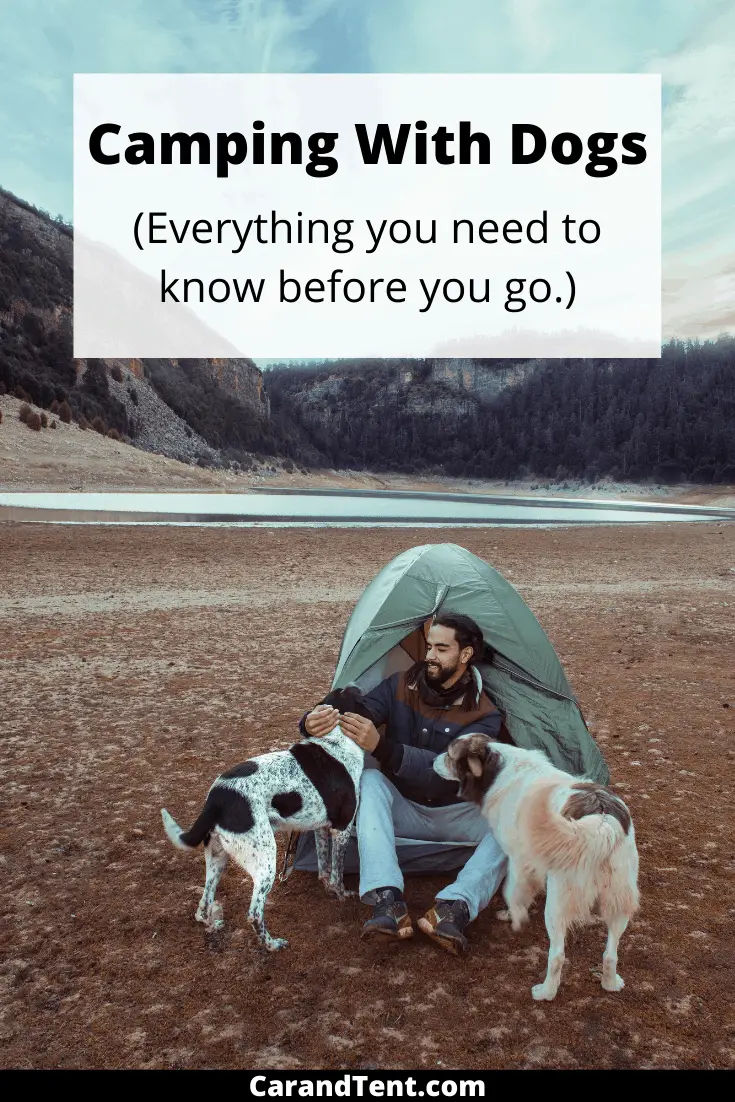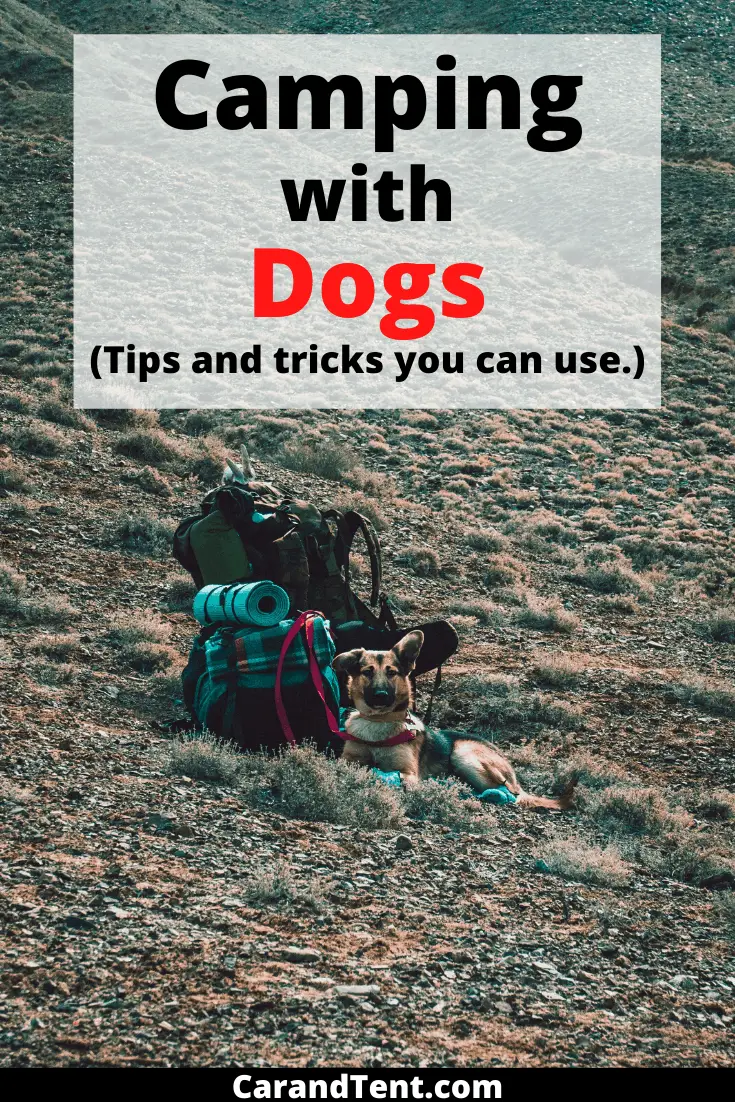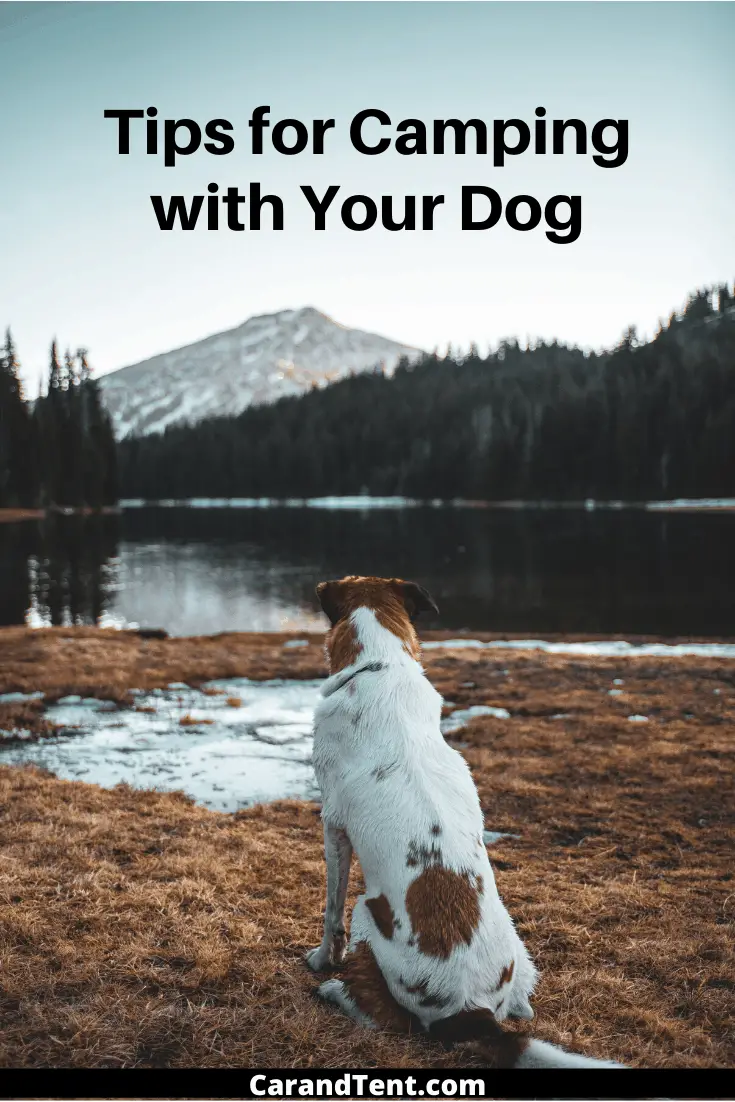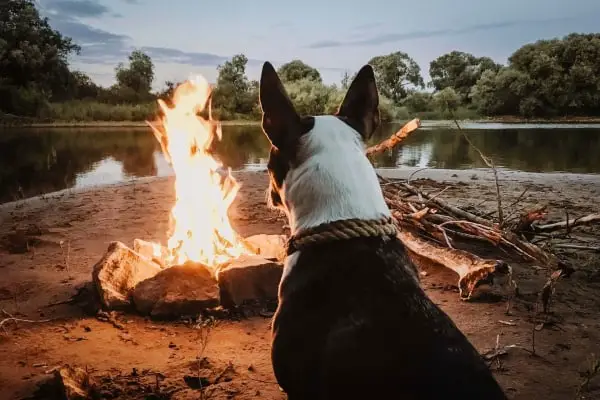
Camping with dogs. Is it possible? Is it worth it?
It is possible to camp with your dogs and if you’re wondering if you can, it’s probably worth it as well. After all, our dogs are not just our best friends, they’re a part of our family so why wouldn’t we want to take them camping with us.
Dogs do complicate things however and there are some extra considerations to keep in mind when bringing your dogs camping with you. In this post, I’ll go over everything you need to know before you go camping with your dogs so that you can have a fun and safe camping trip.
Table of Contents
Planning Your Stay
Before you set your heart on bringing your dog camping with you, you’ll need to make sure that it is permitted. Not all national and state parks allow dogs so you’ll want to check with them first before booking your stay. Also, many parks have pet-friendly and non-pet-friendly campsites so you’ll need to make sure you choose a campsite that permits dogs as well.
In most cases, you’ll be able to find this information on the park’s website. If not, just send the park an email and ask. This is better than calling since you’ll have your answer in writing should you run into any problems when you get there.
Don’t worry if the park you’re interested in won’t allow dogs. You’ll find that most large state and national parks have great campgrounds located nearby and many of these campgrounds will be extremely pet-friendly. You may even be able to find a nice campground with a dog park or doggie daycare nearby.
Choosing a Dog-Friendly Campsite
Here are some quick tips to help you choose a dog-friendly campsite:
- Choose an area that gets less foot traffic.
- Pick a campsite with less vegetation.
- Find a site with water.
Reduce The Foot Traffic Going by Your Campsite
Let’s face it, dogs like to bark. They aren’t doing it to bother people, it’s just the way they communicate. Unfortunately, your fellow campers probably won’t see it that way. Choose an area with less foot traffic going by and your dog will have fewer people to bark at.
This can be done by choosing a campsite at the end of a loop that does not have a bathroom or public water source nearby. You’ll also want to make sure that it does not have any trails running parallel to it as this will also drive a lot of people through the areas around your campsite.
Pick a Site with Less Vegetation
One of my dad’s old dogs was a tick magnet. My dad always said there must have been something special that attracted ticks to the dog. I never gave it much thought until I went for a walk with my dad through a campground. My dad let the dog run through every patch of vegetation we came across. The dog loved it but it was clear to me that this is why the dog, (as well as my dad), were always getting ticks.
Choose an area with less vegetation and you’ll have fewer tick nests to contend with. Not only this, but you’ll have fewer poisonous plants to contend with as well. While dogs won’t suffer the effects of running through poison ivy, oak, or sumac, you certainly will.
When a dog gets the oils from these poisonous plants on them, they stay there until somebody wipes them off. Do you really want to end up cuddling with your dog in your tent after he or she has been running through the poison ivy at the edge of your campsite all day?
Choose a Campsite with a Water Hose
If a pet-friendly campsite with water running to it is available, you’d be wise to take it. This will reduce the number of trips you have to take to the water area, which will reduce the number of times you have to leave your dog behind without you.
Also, having water right at your campsite reduces the amount of water you’ll have to pack for your trip. Remember, you’ll be packing water for both you and your dog and the weight of this additional water supply can add up quickly. Not only this, but water can take up a significant amount of cargo space which you’ll need for your dog’s crate.
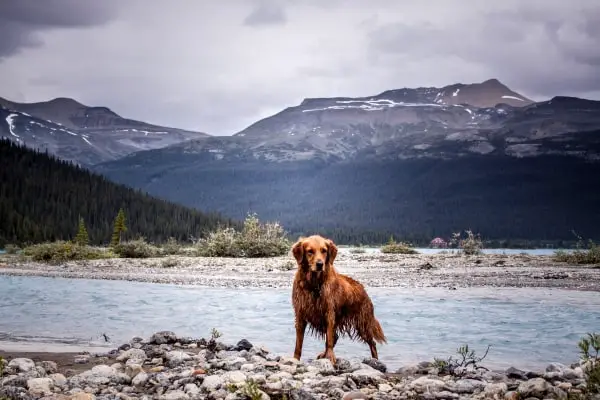
Meeting Your Dog’s Needs While Camping
It’s no secret that dogs need to eat food, drink water, and stay warm, cool, and comfortable. But do you know how much water your dog needs while camping? Do you know how to keep your dog’s food safe from other animals while camping?
Here are some considerations to take into account when camping with your dog:
- Your dog’s food needs to be kept safe from bears and other animals.
- You may need to pack water for your dog so you’ll need to know how much he/she will need each day.
- Just like you, your dog will need protection from the elements.
Keeping Your Dogs Food Safe
Whatever the etiquette is for keeping your food safe will apply to your dog as well. This means that if you need to pack bear canisters for your food, you’ll need to pack them for your dog’s food as well. Some state and national parks will have food lockers and some will have areas for hanging your food up in trees. Take a moment when planning your trip to find out what these rules are and pack accordingly.
Additionally, you’ll need to keep your dog’s food safe while he or she is eating. Remember, you’ll be out in the elements and your dog doesn’t have the hands or even the foresight to grab a hold of his food each time a gust of wind blows through.
For this reason, I recommend that you bring a bowl that can be staked or weighed down so that it can’t blow away. I’d also recommend that you choose specific times to put your food out rather than leaving it out all day. This will help keep smaller animals like birds, mice, and rats from getting to your dog’s food bowl.
Packing Water for Your Dog
According to CesarsWay.com, a dog will consume between .85 to 1.7 ounces of water for each pound each day. This means that your 50-pound dog might drink up to 85 ounces of water a day. Plan to pack this much water as your dog will probably be more thirsty than usual. If you have enough space in your vehicle, pack even more water as it is always better to have more than enough rather than not enough.
As with the food, you’ll want to make sure that the water bowl can’t easily be knocked or blown over. Some people will leave the water out all day while others will not. I prefer to put the water out periodically as it is easy for the water to get dirty out at the campsite and uncovered water can often get hot in the sun. I wouldn’t want to drink hot water on a hot day and I won’t make my dog do it either.
Watch out For Dog Dehydration
It’s easy for a person to verbalize that they are thirsty but almost impossible for a dog to do so. After all, there could be a lot of reasons why your dog is barking. But just because a dog can’t tell you in words that he/she is thirsty, doesn’t mean that she can’t tell you in other ways.
Here are some ways to check to see if your dog is starting to get dehydrated:
- Sticky Gums
- Dry Eyes
- Loss of Skin Pliability
The first sign that your dog is starting to get dehydrated is sticky gums. If you notice that your dog’s gums are starting to look dry, encourage him to drink water. Giving your dog water at this stage should be enough to quickly clear up the dehydration.
After this, your dog’s eyes will start to get dry. At this point, you’ll want to make sure your dog gets water and gets some rest and cover. Get them into the shade to cool them down and make sure that they don’t overexert themselves.
The loss of skin pliability is the next stage of dehydration. At this point, you may want to check to make sure that your dog isn’t suffering from diarrhea. Camping for the first time can sometimes be stressful for dogs and he or she may have an upset stomach. This can lead to diarrhea which can then, in turn, lead to dehydration. Make sure your dog isn’t sick and take steps to remedy any illness that may have befallen him/her.
Protection for The Elements
Some people feel that since dogs are animals they can survive the outdoors better than humans can. This might be true for dogs that have grown up in the wild but it’s far from the truth when we’re talking about domesticated house pets. Our dogs are used to climate-controlled interiors, electricity, and even dog beds and blankets. Some of us even dress our dogs up in little sweaters before heading out on winter walks.
Your dog doesn’t need to be kept in a bubble while you camp but he will need protection from the wind, the rain, the cold, and the heat. We’ll go over the equipment you’ll need in the next section but keep this in mind as you begin to budget for your next trip.
Equipment and Gear Your Dog Will Need When Camping
Essential
- Leash
- Tie-out Stakes
- Crate
- Towels
Most campgrounds and parks will demand that you keep your dog leashed at all times. This is for the safety of others as well as for the safety of your dog. A lot of traffic can go in and out of these parks and you don’t want your dog out and about as it goes by.
Also, keep in mind that small state and national parks have bears, coyotes, wolves, and even mountain lions living in them. A small dog can easily be overwhelmed by any of these animals.

Another thought to keep in mind is that you won’t be able to hold onto a leash the entire time you’re camping. Bring some tie-out stakes and you’ll be able to keep your dog close, safe, and secure while you free your hands up to set up your tent and cook your meals.
Even if you do not normally crate your dog, it is a good idea to bring one with you. This can be used in the event that you need to leave your dog behind at the campsite. While you might not think you’ll ever need to leave your dog behind, it might happen anyway so it is best to be prepared.
Towels are another item that you might not think you need until you do. Even if the forecast is calling for sun, you might still end up camping in the rain. Also, even if it doesn’t rain, your dog might end up in a stream or a lake and you’ll need something to dry her off with before heading back into your tent.
Optional
- Tent Protection
- Tent
- Sleeping Bag
- Sleeping Pad
- Foldable Dog Bowls
- Dog Backpack
Some people like to share their tent and even their sleeping bag with their dogs. This is perfectly fine but you will need to add some protection to the bottom of your tent before doing so. Remember, your dog has long nails and they can easily cause tears and rips in the bottom of your tent. Bring along a thick tarp or pad that you can put along the bottom of your tent so that your dog does not ruin it.
If you want, you can even buy your dog his own tent. Dog tents are sold alongside normal tents but they are much smaller and they’re simple to set up. These tents often look just like standard tents but in miniature sizes. Amusingly enough, I once went to a camping store with a friend who thought the dog tent was just a model of the full-size tent.
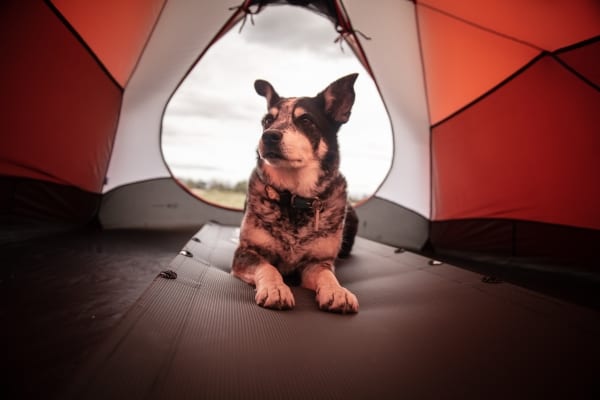
Once your dog is in her tent, you’ll want her to be warm and comfortable. If your dog is sleeping with you, you can buy a double sleeping bag for the two of you. If not, you can buy a separate dog sleeping bag and sleeping pad for your dog.
Do you plan on hitting some of the trails while you’re camping? If so, you may want to bring a foldable dog bowl so that your dog can drink water while you’re out on the trail. You may also want to get a dog backpack so that he can carry his own gear. This is fun for both you and your dog and the adorable hiking pictures you’ll be able to take will be never-ending.
Keeping Your Dog Safe
Here are some of the items you’ll want to consider for keeping your dog safe while you camp.
- Reflective Vest
- Tags
- Pictures
- Preventative-medicine
- First-Aid
A reflective orange vest can help you keep an eye on your dog. It can also help to ensure that others know that your dog is not a wild animal. Oftentimes state parks are near hunting grounds and your dog could possibly get loose.
If your dog is wearing an orange vest, a hunter is unlikely to accidentally mistake him for a game animal. Remember, in many states, there is an open season on coyotes and a small dog could easily be mistaken for a coyote.
Keeping your tags up to date is important at all times but it is especially important when camping. Around town, your neighbor might recognize your dog and bring her home to you. At a state or national park, your dog will be much harder to locate and identify.
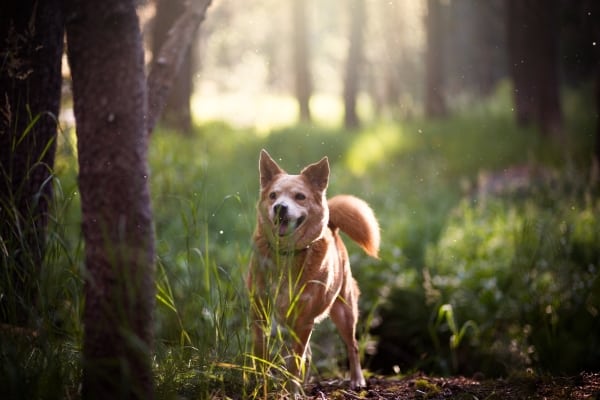
Bring up-to-date pictures of your dog and if you lose your dog you’ll be able to easily relay what she looks like to the rangers on-site. You can also use these pictures to ask other campers to help you locate your dog.
Before heading out you’ll also want to make sure your dog’s shots are up-to-date. In the wild, you’ll be much more likely to attract ticks, fleas, worms, and other pests that can ruin your dog’s health.
A first aid kit is another item you’ll probably want to bring with you. Dogs can share many of the items that you’ll have in your own first aid kit but there are some additional items you may want to consider.
The National Humane Society suggests you bring a pet-specific first-aid manual, a number to the ASPCA poison control center, which is 1-800-426-4435, and self-cling bandages. You may also want to bring a muzzle in case you have to muzzle your dog for safety reasons.
In Closing
Camping with your dog can be a lot of fun and it can help to bring you and your pet closer together. Some additional planning beforehand will help make the experience safer and more productive for both you, your pet, and anyone else you may encounter along the way.
